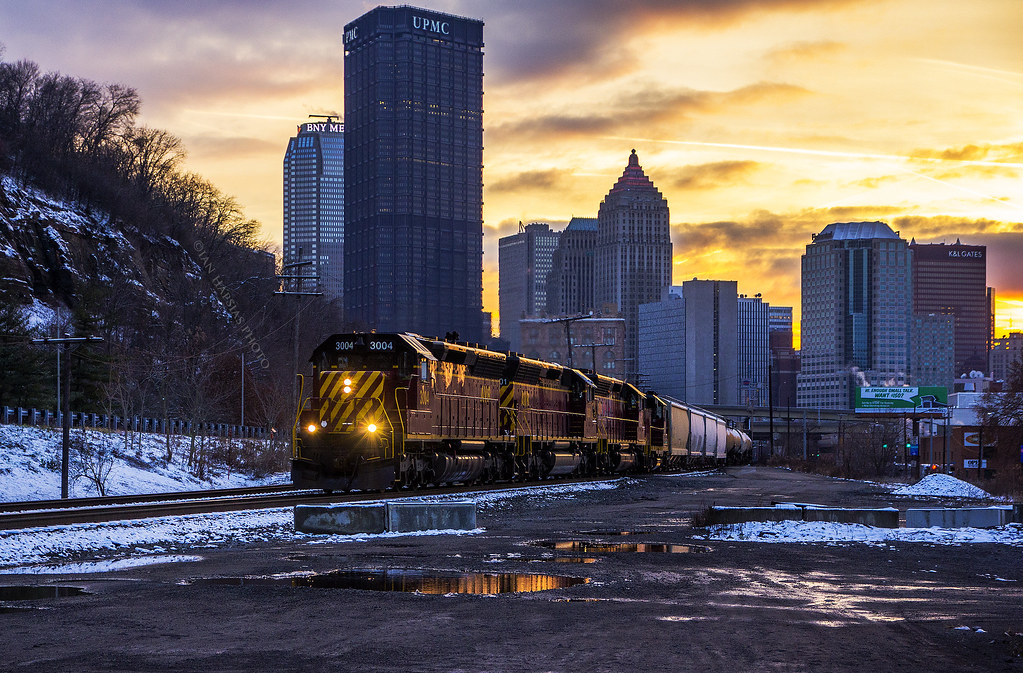#SD45-2
Text
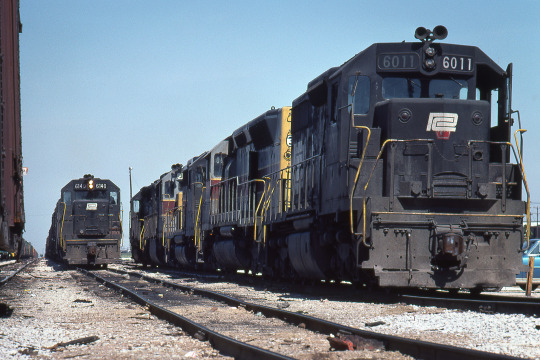
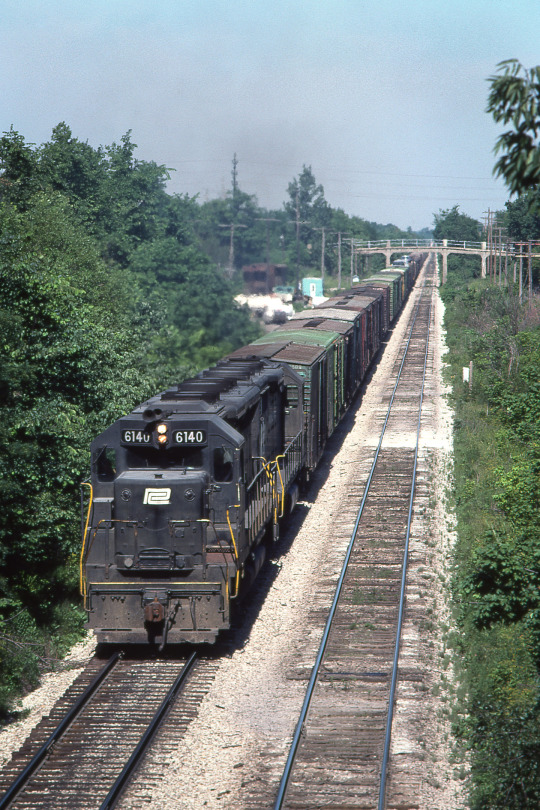
Westbound from Avon
The first image here shows a westbound train ready to depart Avon Yard (in the distance, on the left hand side of the frame). We're on the former Big Four/NYC west of Indianapolis.
Conrail is two months old when these pictures were taken so the power standing off to the side is interesting—three units of the Erie Lackawanna along with a Penn Central unit with a Pennsy logo peeking out. Two of three EL units (SD45-2 and SDP45) were purchased with the idea of having larger fuel capacity for long runs from the east to Chicago without refueling.
The second image has the train down the line about six miles, directly south of Danville, Indiana. We're looking down on the railway from State Road 39.
Two images by Richard Koenig; taken June 5, 1976.
#railroadhistory#railwayhistory#penncentral#conrail#erielackawanna#sdp45#sd45-2#danvilleindiana#avonindiana#avonyard#bigfour#newyorkcentral
65 notes
·
View notes
Video
Bicentennial Display by NAPM Model Railroad Club
Via Flickr:
Eight locomotives in bicentennial liveries assemble for a special event in NAPM's Ottawa yard in 1975. This photo was inspired by an iconic prototype photo taken by Trains magazine at the Belt Railway of Chicago's 87th Street yard; it was taken during a special NAPM photo session featuring 22 member-owned bicentennial locomotives. Photo by Mark Mathu. Visit the HO scale NAPM club on-line at www.napmltd.org.
#SD45-2#SD45#GP38-2#MP15#diesel#locomotive#SD40T-2#EMD#SD40#SD#SSW#MP15DC#scenery#yard#GTW#GP#BN#NAPM#road name#_Mark Mathu#SD40-2#GP38#Burlington Northern#GT#Grand Trunk#Grand Trunk Western#HO#Milwaukee#North American Prototype Modelers#Saint Louis Southwestern
19 notes
·
View notes
Text
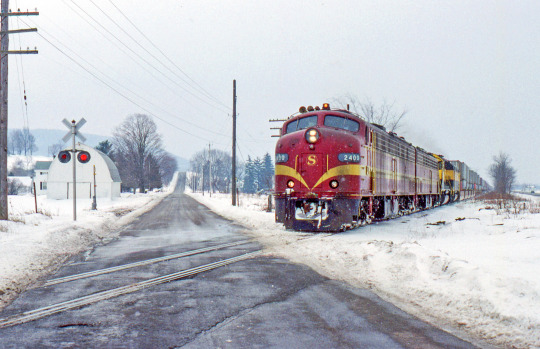
Here's two Chicagoland expatriates, the former BN 9921 and 9915, running for their next owner NYS&W, powering a northbound BH-2 double stack consist up the Syracuse side at Tully Center Road on the morning of 15 February 1997, assisted by an SD45 and an F45.
60 notes
·
View notes
Text


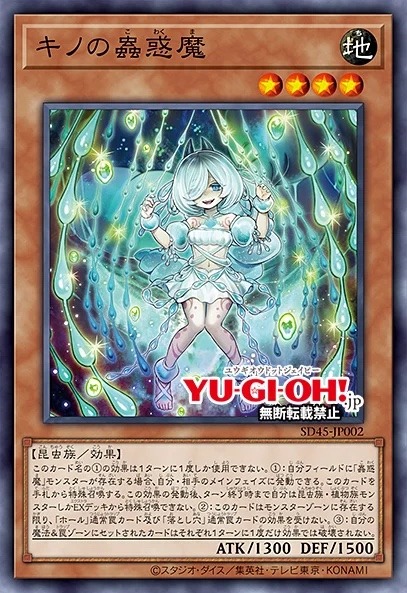


“Structure Deck: Forest of the Traptrix”
Price: 1320 Yen
Release Date: December 3rd, 2022
A pre-constructed “Traptrix” Deck appears for the theme that made its debut in 2013!
“Traptrix” is a Deck of Plant and Insect monsters that primarily fight with Trap Cards, and this product consolidates existing related cards, while also making it stronger with brand new cards!
And follow that up with a Deck Power-Up Pack! The “Deck Power-Up Pack” contains 5 different cards, one of which is randomly a Secret Rare foil!
● 1 Pre-Constructed Deck of 43 Cards
● 1 Power-Up Pack of 5 different cards
● 1 Special Duel Field / Playing Guide
● Package Size: H158×W90×D30mm
※ Pre-Constructed Deck: 1 Ultra Rare, 5 Super Rares, 8 Parallels
※ Deck-Power-Up Pack: 1 Ultra Rare, 4 Super Rares, 1 Card is Randomly a Secret Rare
SD45-JPP01 Citris no Kowakuma (Traptrix Pinguicula)
Rank 4 EARTH Plant Xyz Effect Monster
ATK 2500
DEF 300
Materials: 2 Level 4 monsters
You can only use the 2nd and 3rd effect of this card’s name each once per turn.
(1) This card with material is unaffected by Trap effects and by activated effects from any other monster with the same Type as any of those materials.
(2) You can detach 1 material from this card; add 1 “Traptrix” monster from your Deck to your hand.
(3) If a monster(s) that is owned by your opponent is sent to the GY, or banished, by card effect: You can attach 1 of them to this card as material.
Note: This card is named after Pinguicula, the scientific name of the Butterwort, a type of carnivorous plant in the family Lentibulariacaea that use their sticky glandular leaves to lure, trap and digest insects.
SD45-JP002 Kino no Kowakuma (Traptrix Arachnocampa)
Level 4 EARTH Insect Effect Monster
ATK 1300
DEF 1500
You can only use the 1st effect of this card’s name once per turn.
(1) During the Main Phase, if you control a “Traptrix” monster (Quick Effect): You can Special Summon this card from your hand, also you cannot Special Summon monsters from the Extra Deck for the rest of this turn, except Insect and Plant monsters.
(2) Unaffected by the effects of “Hole” Normal Traps.
(3) The first time each Set card in your Spell & Trap Zone would be destroyed by card effect each turn, it is not destroyed.
Note: This card derives its name from Arachnocampa, a genus of fungus gnats with a bioluminescent larval stage that dwell in caves and grottos throughout Oceania. They use snares of made of silk threads around their next, to trap prey.
SD45-JP027 Kyouwaku no Otoshiana (Delusion Trap Hole)
Normal Trap Card
You can only activate 1 card with this card’s name per turn.
(1) If your opponent Special Summoned a monster this turn: Target 1 monster they control with 2000 or more ATK; destroy it, then, if you have a “Hole” Normal Trap in your GY, you can banish 1 monster from your opponent’s GY.
SD45-JPP02 Atypus no Kowakuma (Traptrix Atypus)
Link-3 EARTH Insect Link Effect Monster
ATK 1800
Link Arrows: Middle-Left, Middle-Right, Bottom-Center
Materials: 2+ monsters, including a Plant or Insect monster
(1) This Link Summoned card is unaffected by Trap effects.
(2) “Traptrix” monsters you control gain 1000 ATK while you have a Normal Trap in your GY.
(3) Once per turn: You can target face-up cards your opponent controls up to the number of Insect and Plant monsters you control; negate their effects (until the end of this turn), then you can banish 1 Normal Trap from your GY, and if you do, destroy 1 of the targeted face-up cards.
#yugioh#ygo#yugioh zexal#yugioh arc v#yugioh vrains#yugioh gx#yugioh 5ds#yugioh sevens!#yugioh go rush
34 notes
·
View notes
Text
2 of the engines I mentioned in the Top 5 Sexy Trains.... the way I saw them... the engines the way they are in this world doesn't show how handsome they all really were!
Hustle Muscle #400 , a SD45

Super Chief #5142 , an EMC E1 ( @taiyakipress 's engine )

11 notes
·
View notes
Text
Just a bit ago today, I released a post showing my OCs from the Southern Pacific. Now this post will go over my OCs from the opposite Pacific railroad, found in the north; the…

Now these engines make up BNSF’s Northern Pacific heritage fleet…

and they’re only found in railroad territories that were owned by Northern Pacific. And these OC engines from the “Main Street of the Northwest” engines are…
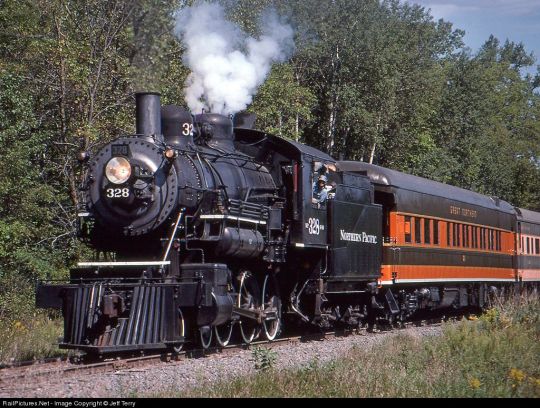
Bonnie, the NP class S-10 4-6-0 #328

Clemont, the NP class S-14 4-6-0 #1364
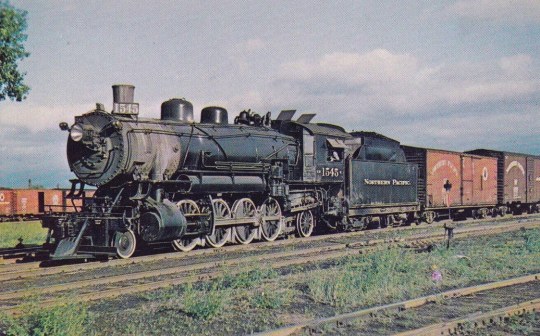
Zoe, the NP class W 2-8-2 #1545

Cameron, the NP class W-3 2-8-2 #1706

Robin, the NP 4-6-6-4 class Z-8 #5141
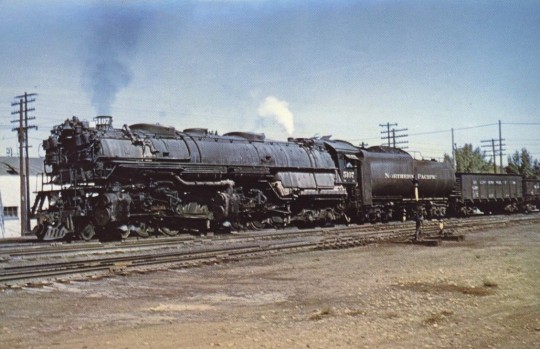
Williams, the NP 4-6-6-4 class Z-6 #5107

Ivy, the 2-8-8-4 class Z5 #5003

Melvin, the 2-8-8-4 class Z5 #5005
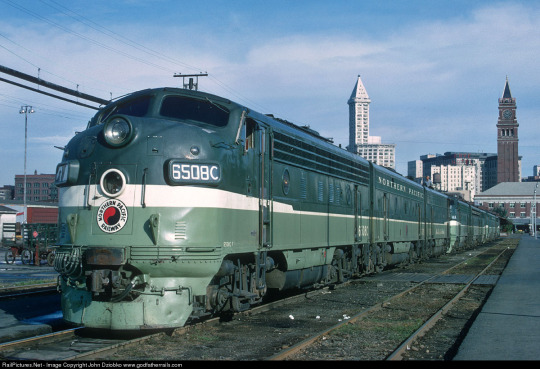
Rebecca, the EMD F7(a) #6508 and first Mainstreeter engine

Oliver, the EMD F7(a) #6513 and second Mainstreeter engine

Henry, the EMD F7(a) #6703 and third Mainstreeter engine

Molly, the EMD F7(a) #6702 and first North Coast Limited engine

Emerald, the EMD F7(a) #6705 and second North Coast Limited engine

Andreas, the EMD F7(a) #5507 and third North Coast Limited engine
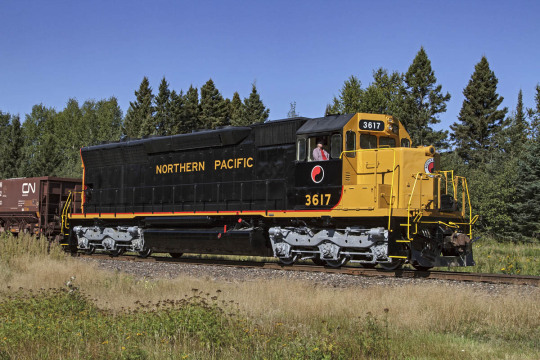
Lasseter, the EMD SD45 #3617
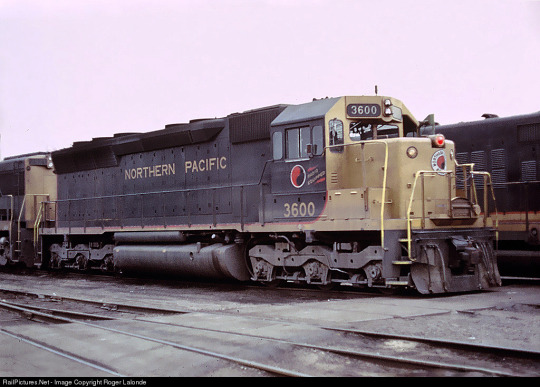
Wilma, the EMD SD45 #3600

Marlin, the EMD SD45 #3619
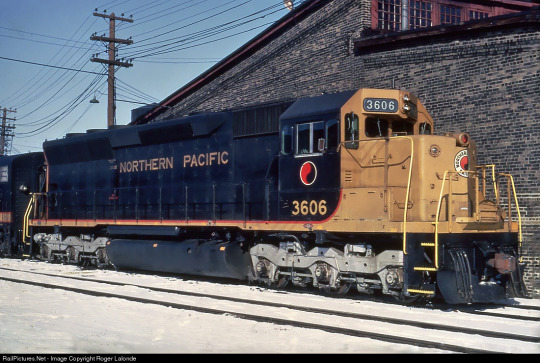
Remy, the EMD SD45 #3606
#northern pacific#np#steam locomotive#steam engine#diesel locomotive#diesel engine#locomotive#train#trains#railroad#railroads#railway#railways#rail#rails#thomas and friends#thomas the tank engine#ttte#ttte oc#the genie team#passenger train#passenger cars#freight train#freight cars#genie team
4 notes
·
View notes
Video
NS KC32/AVR Extra Job @ Pittsburgh PA por Ian M. Hapsias
Por Flickr:
Dusk is quickly approaching as NS KC32 (at the time of this photo, now called as NS AVR01 in current times), the AVR transfer train, returns back east with their pick up from the Norfolk Southern interchange at Island Avenue Yard on Pittsburgh's northside. The train will jump back onto home rails at CP-BLOOM, about 2 miles further east of the picture here, at CP-PITT. Once back on home rails the train will venture over to their operations base at the former Baltimore & Ohio (B&O) Glenwood Yard in Pittsburgh's Hazelwood neighborhood. At Glenwood, the train is broken down accordingly for each train that runs on their system day in and day out to ensure the cars get to their proper customer in a quick and orderly fashion. Today's train is sporting 4 corporate painted engines, all stenciled for Carload Express' Allegheny Valley Railroad (A.V.R.). The first 3 units are former EMD built SD45/45-2's that were rebuilt to SD40-2 standards after their first retirement from their owner railways. The only difference is in internal, as the SD45/45-2's were built with 645E3 twenty-cylinder engine generating 3,600 hp. Upon retirement a large number of the SD45's were being rebuilt to SD40-2 standards with a EMD 16-cylinder 645E3 generating 3,000 horsepower, but keeping the iconic SD45 "flared" carbody. Getting out of technical's of the engines and back to the picture itself, I have to truly give credit to the revolutionary invention of .RAW file shooting. If it wasn't for me shooting so, this file would have been a complete and utter loss being it was so dark and badly botched. A tedious amount of effort in Photoshop RAW editor and photoshop itself brought this photo back to life and so evenly balanced. It still stands to this day as one of my best shots I've taken and taught me well to never count a photo out if the initial exposure was botched. All brought to you by the 3 letters of R, A and W.
5 notes
·
View notes
Photo

Day 23: EMD SDP40F
Info from Wikipedia:
The EMD SDP40F was a six-axle 3,000 hp (2.2 MW) C-C diesel–electric locomotive built by General Motors Electro-Motive Division (EMD) from 1973–1974. EMD built 150 for Amtrak, the operator of most intercity passenger trains in the United States. Amtrak, a private company but funded by the United States government, had begun operation in 1971 with a fleet of aging diesel locomotives inherited from various private railroads. The SDP40F was the first diesel locomotive built new for Amtrak and for a brief time they formed the backbone of the company's long-distance fleet.
A series of derailments in the mid-1970s shattered Amtrak's confidence in the locomotive, and many railroads banned it from their tracks. Multiple investigations pointed to issues with the locomotive's trucks, the weight of the water and steam generators used for train heating, or the harmonic vibration of baggage cars behind the locomotive. In 1977 Amtrak decided to move on from the SDP40F in favor of the EMD F40PH, which was already in use on short-distance routes. Amtrak traded most of its fleet into EMD; the components were incorporated into new F40PHs. The remainder were traded to the Atchison, Topeka and Santa Fe Railway (ATSF) for use in freight service. The Santa Fe rebuilt the locomotives and designated them SDF40-2. The Burlington Northern Santa Fe Railway (BNSF), successor to the Santa Fe, retired them in 2002. One of them is preserved.
Amtrak assumed operation of most intercity rail passenger service in the United States on May 1, 1971. Until then such services were operated by various private railroads. The private railroads chose to retain their second generation passenger locomotives for freight service, or to operate the various commuter services which, by law, did not pass to Amtrak. To operate these intercity services the Amtrak had to buy or lease from the private railroads whatever locomotives remained. This left Amtrak with an aging and mechanically-incompatible fleet of diesel locomotives. The mainstays of Amtrak's road diesel fleet were veteran E units and F units, which were 10–20 years old and due for replacement.
The SDP40F was a full-width cowl unit. It was based on the EMD FP45 passenger locomotive and EMD SD40-2 freight locomotive. All three shared the EMD 645E3 diesel prime mover, which developed 3,000 hp (2.2 MW). The locomotive had a gear ratio of 57:20. Maximum speed at full horsepower was 94 mph (151.3 km/h); the locomotive exceeded 100 miles per hour (160.9 km/h) in tests. There were doubts at the time about Amtrak's long-term viability, so the locomotives were designed for easy conversion to freight locomotives should Amtrak cease operation.
In the early 1970s Amtrak's passenger car fleet was steam-heated; Amtrak's requirement called for two steam generators. These were located at the rear of the locomotive. Forward of the generators was a 1,350-US-gallon (5,110.3 l; 1,124.1 imp gal) water tank. This tank rested above the floorline. The lateral motion of the water within was later implicated in several derailments. The primary underbody tank was split between water and diesel fuel, carrying 2,150 US gallons (8,138.6 l; 1,790.2 imp gal) of water and 2,500 US gallons (9,463.5 l; 2,081.7 imp gal) of diesel. Provision was made for eventual conversion to head-end power (HEP), but it was never carried out.
EMD based the SDP40F name on the existing SDP40. Several years earlier, EMD had made similar versions of the SDP45 and SD45 in a full-width cowl unit, which it named FP45 and F45. Although the SDP40F was externally nearly identical to the FP45, EMD chose not to give the new locomotive a similar name such as FP40. EMD wanted to avoid adding a new locomotive type to their catalog due to price controls in effect in the early 1970s. The following year, the F40C name was used for a similar locomotive ordered by the Chicago, Milwaukee, St. Paul and Pacific Railroad (the "Milwaukee Road"), equipped with HEP instead of steam generators.
There were several minor differences between the first 40 locomotives built and later examples. The most important was the installation of lower-profile cooling fans and air horns to avoid clearance problems in the Eastern US.
Amtrak ordered 150 SDP40Fs, in two batches. The first order, placed on November 2, 1972, was for 40 locomotives, at a cost of $18 million. A second order, for 110 locomotives at $50 million, followed on October 12, 1973. These orders were Amtrak's first for new-build locomotives.[18] Amtrak deployed the original 40 locomotives on long-distance trains in the Western United States. The locomotives entered revenue service on June 22, 1973, hauling the Super Chief from Chicago to Los Angeles over the Atchison, Topeka and Santa Fe Railway. SDP40Fs were also used on the Burlington Northern Railroad. The arrival of the second order enabled Amtrak to deploy the SDP40Fs throughout the country, displacing the inherited E-units.
In late 1975 J. David Ingles called the SDP40Fs the "stars of Amtrak's long-distance trains," but engine crews reported that the locomotives rode poorly compared to the E-units they had replaced. Even as Amtrak and EMD investigated the ride quality, the SDP40F was involved in a series of derailments that would lead to an end to its career as a passenger locomotive. Between 1974–1976 the Federal Railroad Administration (FRA) identified thirteen incidents for which the locomotive was responsible. None of the incidents were serious, but their frequency was a concern. Most of the derailments occurred on trains with two SDP40Fs on the front and at least one trailing baggage car. While the rear truck of the second locomotive and the front truck of the baggage car were pinpointed as the source of the derailment, the actual cause of the derailments was unclear.
EMD, Amtrak, the Association of American Railroads (AAR), and the FRA tested the locomotive thoroughly, with suspicion falling on the "hollow bolster" truck design. In the end, the investigators theorized that the steam generators and water tank may have made the rear of the engine too heavy and created too much lateral motion. Later FRA investigations concluded that the actual culprit was the light weight of the baggage cars, which caused harmonic vibrations when placed directly behind the much heavier SDP40F. A contributing factor was the sometimes poor quality of track the locomotive operated over.
Amtrak took several corrective measures, including operating with a reduced speed on curves, emptying the smaller of the two water tanks to reduce lateral motion, and making various alterations to the trucks. The measures helped, but the trouble continued. Several railroads, including the Burlington and the Chesapeake and Ohio Railway (C&O), banned the "rail breakers" from their tracks (they were suspected or known to be causing the spreading of rails because of their lateral swaying, which may have contributed to the derailments)[citation needed]. For the Chicago–Seattle Empire Builder, the speed restrictions added 6 hours to what had been a 46-hour schedule. Another important development was the unusually harsh winter of 1976–1977, which sidelined many of Amtrak's aging steam-heated coaches. Amtrak suspended numerous routes and pressed the new HEP-equipped Amfleet I coaches, designed for short runs, into service. The new EMD F40PH, intended for short-distance service and equipped with HEP, handled these trains.
In the spring of 1977 Amtrak faced a power crisis. In addition to the SDP40Fs derailing, Amtrak was having trouble with two other six-axle designs. The GE E60CP and E60CH electric locomotives were having derailment problems. The GE P30CH had the same truck design as E60s and rode poorly, although it did not exhibit the same tendency to derail. Amtrak decided to abandon the SDP40F in favor of the F40PH, a four-axle design with none of the riding problems of the six-axle locomotives. Amtrak traded 40 SDP40Fs back to EMD. Components including the prime mover were installed into an F40PH's frame. Between 1977–1987 Amtrak traded 132 of the SDP40Fs back to EMD for F40PHRs. The SDP40F remained in service on the Santa Fe longer than elsewhere, although the arrival of HEP-equipped Superliner cars on the Western routes displaced them from there as well. The last SDP40Fs left the Amtrak roster in 1987. The remaining Amtrak SDP40F's that weren't sold to the ATSF (seen below) are presumed to have been scrapped.
In 1984 Amtrak, low on light-duty power, traded 18 SDP40Fs to the Santa Fe for 43 switchers: 25 CF7s and 18 SSB1200s. Santa Fe rebuilt the traded locomotives for freight use. Modifications included removing the steam generators and regearing for lower speed. The locomotives were also given front steps and platforms, and notched noses in order to improve boarding access. The rebuilt locomotives were designated SDF40-2. The SDF40-2s continued in service with the BNSF Railway, successor to the Santa Fe, until their retirement in 2002.
One SDF40-2, ex-Amtrak No. 644, was acquired by Dynamic Rail Preservation Inc. and is in Boulder City, Nevada having been previously displayed in Ogden, Utah. It has been renumbered to its Santa Fe-era 6976 number and returned to operation in November 2019.
models and route by: American Trainz Group, trainzman54, Auran, and Download Station
#EMD#EMD SDP40F#Amtrak SDP40F#SDP40F#Amtrak#Diesel Locomotive#Trainz Simulator#Trains#Advent Calendar#Christmas#Christmas 2022 🎄🎅🎁
2 notes
·
View notes
Note
The SD40-2 was introduced in January 1972 as part of EMD's Dash 2 series, competing against the GE U30C and the ALCO Century 630. Although higher-horsepower locomotives were available, including EMD's own SD45-2, the reliability and versatility of the 3,000-horsepower (2,200 kW) SD40-2 made it one of the best-selling models in EMD's history, edged only by the GP9, and the standard of the industry for several decades after its introduction. The SD40-2 was an improvement over the SD40, with modular electronic control systems similar to those of the experimental DDA40X.
Peak production of the SD40-2 was in the mid-1970s. Sales of the SD40-2 began to diminish after 1981 due to the oil crisis, increased competition from GE's Dash-7 series and the introduction of the EMD SD50, which was available concurrently to late SD40-2 production. The last SD40-2 delivered to a United States railroad was built in July 1984, with production continuing for railroads in Canada until 1988, Mexico until February 1986, and Brazil until October 1989.
The SD40-2 has seen service in Canada, Mexico, Brazil and Guinea. To suit export country specifications, General Motors designed the JT26CW-SS (British Rail Class 59) for Great Britain, the GT26CW-2 for Yugoslavia, South Korea, Iran, Morocco, Peru and Pakistan, while the GT26CU-2 went to Zimbabwe and Brazil. Various customizations led Algeria to receive their version of a SD40-2, known as GT26HCW-2.
very interesting. thank you for this information.
2 notes
·
View notes
Photo
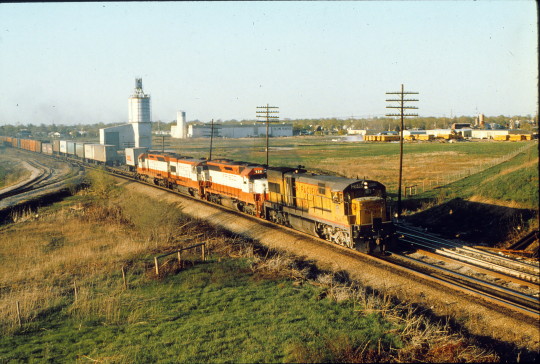
UP U30C 2846, SD45 928, U30B 852 and SD45 908 at Olathe, Kansas in April 1979
1 note
·
View note
Text
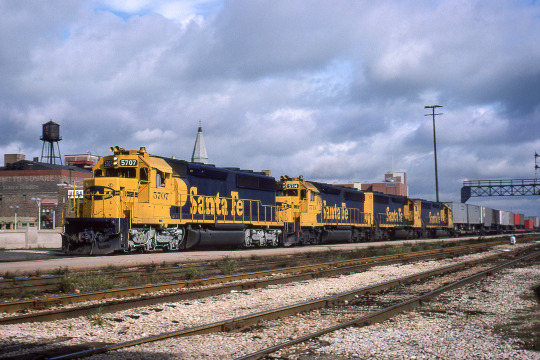
Westbound at Joliet
One more early image, taken the same day as my previous post...
The train pictured may be the famed Super-C, a hot TOFC train that ran between Chicago and the west coast. It's westbound near the tower at Joliet once again. The Santa Fe ran parallel to the GM&O at this spot; the train will cross the Rock Island within seconds.
The lead locomotive is an SD45-2 built in May of 1974, so only a little over a year old. It has a 20-cylinder prime mover that produced 3600 horsepower.
One photograph by Richard Koenig; taken September 20th 1975.
#railroadhistory#railwayhistory#filmphotography#jolietillinois#jolietil#joliet#santaferailway#chicagorockisland&pacific#rockisland#gulfmobile&ohio#cri&p#santafe#atsf#gm&o
29 notes
·
View notes
Text
Top 10 Best diesel sounds [2022]
Top 10 Best diesel sounds [2022]
1. Bachmann Trains Rio Grande #5336 EMD SD45 DCC Sound Equipped Diesel Locomotive Train (N Scale)
Buy On Amazon
DCC – Sound Value equipped for speed, direction, lighting, and 16-bit polyphonic sound
Preforms best on 11. 25″ radius curves or greater
N Scale – 1: 160
Item Package Weight: 0.5 pounds
2. Diesel Men’s DZ4328 Mega Chief Silver-Tone Stainless Steel Watch
Buy On Amazon
Silver-tone…

View On WordPress
0 notes
Text

ALTO 154
Big SD45-2 No. 6665 and a mate shove a westbound Conrail freight around Horseshoe Curve on 8 August 1992, passing the Ledge and bending into McGinley's Curve.
36 notes
·
View notes
Text
Conrail 6666 at Cresson, PA.
Conrail 6666 at Cresson, PA.
Working with a Leica M3 fitted with a 50mm Summicron, I exposed this photo of Conrail SD45-2 6666 on the wye at Cresson, Pennsylvania in July 1989.
I loaded the camera with Kodak Plus-X (ISO 125). Interestingly, back then I rarely used this once-popular film in the 35mm format as instead I tended to prefer either Kodak’s Tri-X (ISO 400) or Ilford FP4 (ISO 125).
I don’t recall why I opted for…

View On WordPress
#Kodak Plus-X#SD45-2#I exposed this photo of Conrail SD45-2 6666 on the wye at Cresson#Working with a Leica M3 fitted with a 50mm Summicron
1 note
·
View note
Video
The Moran Brothers last hurrah by Greg Brown
Via Flickr:
Flooding in late December 1996 put the Shasta Route and the Feather River Canyon out of service. Aside from going to Salt Lake, the only way to get up and down the west coast by rail was a detour over Donner Pass and the Modoc Line. For a couple of weeks, the Modoc Line was busier than it had ever been. In this image, an eastbound (southbound) passes a train parked in Moran siding. Most of the detour trains ran in fleets of five or six at a time, generally at speeds of 15-20 MPH. Any railfans that were there experienced the ultimate Modoc turkey shoot. Alas, on July 1, 1997, Union Pacific closed the Modoc for good as a through route. The rails were removed a few years later.
#Southern Pacific#Union Pacific#SP#UP#Modoc Line#Lassen County#NCO#Detour#Desert#Trains#Railroads#California#Northern California#EMD#SD40T-2#SD45
28 notes
·
View notes
Photo
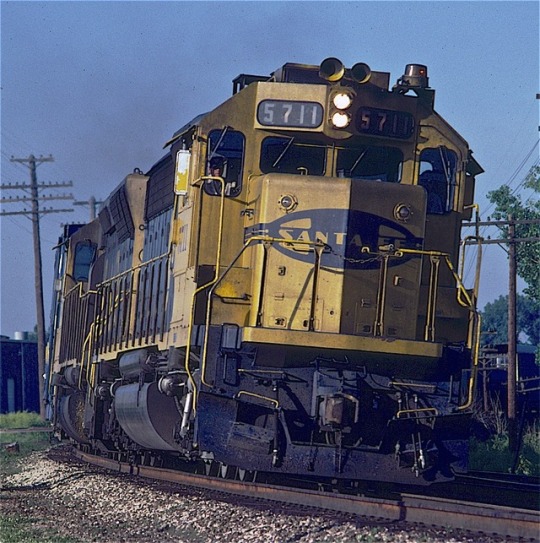
Santa Fe SD45-2 5711 on the super-elevated curve at Lockport Lockport, Illinois June 20, 1980 Photo by Bill Johnson
#santa fe#at&sf#freight train#train#trains#trainspotting#track#tracks#locomotive#diesel locomotive#EMD#emd SD45-2#RR#rail#rails#railroad#railroads#railway#railways#industrial#motion#dynamic#elevated#super-elevated#Lockport#illinois#warbonnet#santa Fe warbonnet
176 notes
·
View notes
